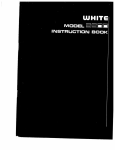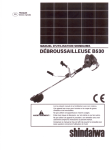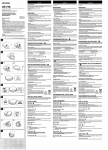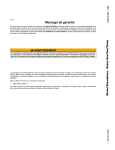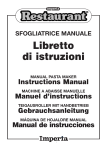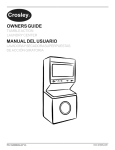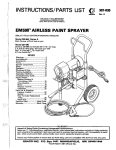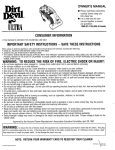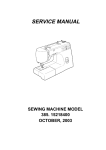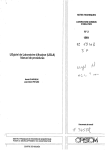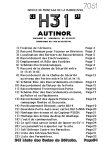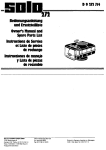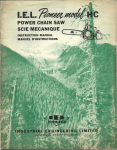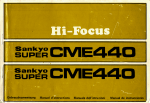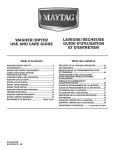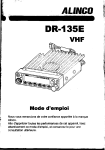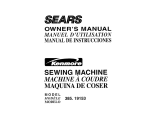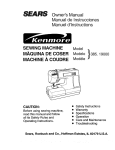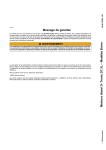Download dLIUU"
Transcript
Portable Zigzag Sewing Machine
Machine a coudre Compacte
d L I U U "
INSTRUCTION MANUAL
MANUEL D'INSTRUCTIONS
"IMPORTANT SAFEGUARDS"
"IMPORTANT SAFETY INSTRUCTIONS"
"When using an electrical appliance, basic safety precautions should always be followed, including the following:"
"Read all instructions before using this sewing machine."
' I D A N G E R T Oreduce the risk of electric shock:"
1. "An appliance should never be left unattended when plugged in. Always unplug this appliance from the electric outlet
immediately after using and before cleaning."
2. "Always unplug before relamping. Replace bulb with same type rated 15 Watts."
II
WARNINGTO
reduce the risk of burns, fire, electric shock, or injury to persons:"
1. "Do not allow to be used as a toy. Close attention is necessary when this appliance is used by or near children:"
2. "Use this appliance only for its intended use as described in this manual. Use only attachments recommended by the
manufacturer as contained in this manual."
3. "Never operate this appliance if it has a damaged cord or plug, if it is not working properly, if it has been dropped or
damaged, or dropped into water. Return the appliance to the nearest authorized dealer or service center for examination,
repair, electrical or mechanical adjustment."
4. "Never operate the appliance with any air openings blocked. Keep ventilation openings of the sewing machine and foot
controller free from the accumulation of lint, dust, and loose cloth."
5. "Keep fingers away from all moving parts. Special care is required around the sewing machine needle."
6. "Always use the proper needle plate. The wrong plate can cause the needle to break."
7. "Do not use bent needles."
8. "Do not pull or push fabric while stitching. It may deflect the needle causing it to break."
9. "Switch the sewing machine off ("0") when making any adjustments in the needle area, such as threading needle, changing
needle, threading bobbin, or changing presser foot, and the like."
10."Always unplug sewing machine from the electrical outlet when removing covers, lubricating, or when making any other
user servicing adjustments mentioned in the instruction manual."
11. "Never drop or insert any object into any opening."
12."Do not use outdoors."
13."Do not operate where aerosol (spray) products are being used or where oxygen is being administered."
14."To disconnect, turn all controls to the off ("0") position, then remove plug from outlet."
15."Do not unplug by pulling on cord. To unplug, grasp the plug, not the cord."
"SAVE THESE INSTRUCTIONS"
"This sewing machine is intended for household use only."
r
Be sure to disconnect the plug from the wall outlet
before replacing the sewing machine needle, or
lubricating the machine.
When not in use, be sure unplug the machine.
Do not use thinner or other similar sol!rents to clean
the machine.
Do not expose the machine to direct sunlight or humid
atmosphere.
I
"NOTES DE SECURITE IMPORTANTES"
"Lorsque vous utilisez un appareil electrique, des precautions elernentaires doivent toujours &re suivies, comrne celles-ci."
"Lisez attentivernent ces instructions avant d'utiliser cette machine a coudre."
II
DANGERp
o u r reduire le risque dYlectrocution.'
1. "Un appareil ne doit jarnais a r e laisse sans surveillance lorsqu'il est branche.Toujours debrancher cet appareil du secteur
irnrnediaternent apres utilisation et avant de le nettoyer."
2. "Toujours debrancher avant de changer I'arnpoule. Rernplacer I'arnpoule par une du rngme type (15 watts)."
"ATTENTION
pour les risques de brclure. Oectrocutions et de blessure~.'~
1. "Ne pas utiliser cet appareil cornrne un jouet. Porter une attention particuliere lorsque cet appareil est utilise par des
enfants."
2. "N'utiliser cet appareil que dans le cadre de ses fonctions, rnentionnees dans le present rnanuel. N'utiliser que lespieces
fournies ou recornrnandees par le fabricant dans ce rnanuel."
3. "Ne pas utiliser cet appareil si une de ses prises ou cordons est endornrnage, ou s'il ne fonctionne pas correcternent. S'il
est tornbe, a ete endornrnage, tornbe dans I'eau, retourner I'appareil aupres de votre revendeur le plus proche pour un
reparation, ou une verification technique ou electrique."
4. "Ne jarnais utiliser cet appareil dans un lieu depourvu d'aeration. Maintenez une ventilation suffisante autours de la
machine et du rheostat et eviter la poussiere et les chutes de tissus aux alentours des sources d'aeration de la machine."
5. "Eloigner vos doigts des pieces mobiles de la machine. Faites particulierernent aux mouvernents de I'aiguille."
6. "Toujours utiliser la plaque aiguille appropriee. Un plaque non appropriee peut faire casser I'aiguille."
7. "Ne pas utiliser d'aiguilles courbes."
8. "Ne pas tirer ou pousser le tissu lorsque vous cousez., cela pourrait abirner, voire casser I'aiguille."
9. "Mettre I'interrupteur de la machine en position <OFF> lorsque vous rnanipulez I'aiguille, ou I'enfilez. De rnerne lorsque
vous changez le pied presseur."
1O."Debranchez toujours votre machine lorsque vous 6tez le capot, lorsque vous la nettoyez, ou pour tout autre mani~ulation
mentionnee dans le rnanuel d'instruction."
11."Ne jarnais laisser d'objet entrer dans les ouvertur~
es de la machine."
12."Ne pas utiliser a I'exterieur."
13."Ne pas utiliser lorsqu'un aerosol a ete pulverise, (,u lorsque de I'oxygene a ete adrninistre."
14."Avant de debrancher la machine, rnettre I'interrupteur en position eteint <OFF>."
15."Ne pas debrancher en tirant sur le cordon. Pour debrancher, tenir la prise, pas le cordon."
"RETENEZ CES INSTRUCTIOINS"
"Cette machine a coudre est destinee a une utilisatioridornestique uniquernent."
Soyez certain8 de dhconnecter la prise d u secteur
Avant de changer une aiguille, ou de nettoyer la
Machine.
Lorsqu'elle n'est pas utilish, dhbranchez la machine.
Ne pas utiliser de diluants ou de solvants pour nettoyer
la machine.
Ne pas exposer la machine aux rayons du soleil ou a
des atmosphere humide.
-
CONTENTS /TABLE DES MATI@RES
CONTENTS
Important safeguards ........................................................... 1
Accessories ......................................................................... 3
Principal parts ...................................................................... 4
Major functions ................................................................. 5.6
Winding the bobbin ........................................................... 7. 8
Threading the machine ................................................... 9. 10
Automatic Needle Threading
Pulling Up The Bobbin Thread
Changing the presser feet ................................................. 11
How to remove and insert the needle ................................ 11
Needle to be purchased .................................................... 12
Types of feet and their application ..................................... 12
How to adjust thread tension ........................................ 13
Stitch length of each stitch pattern .................................... 13
List of fabric. thread and needle ........................................ 14
INDEX
Consignes de securiete ....................................................... 2
Accessoires ......................................................................... 3
..
P~ecesprincipales................................................................ 4
Fonctions principales........................................................ 5.6
Remplir la canette ............................................................. 7. 8
Enfiler la machine ........................................................... 9. 10
Enfilage automatique de I'aiguille
Faire remonter le fil de canette
Changer de pied presseur ................................................. 11
Comment mettre et retirer I'aiguille ................................... 11
Aiguilles a acheter ............................................................. 12
Les differents.pieds et leur utilisation ................................ 12
Comment ajuster la tension du fil ...................................... 13
Longueur des differents points .......................................... 13
Tissus. fils et aiguilles ........................................................ 14
Blindstitch presser foot
Pied pour surfilage
Overcasting foot
Pied ourlet invisible
Straight stitch .................................................................... 15
Reverse stitch ................................................................... 16
Zigzag stitch ...................................................................... 17
Stitch width vs stitch length
Overcasting ....................................................................... 17
Bottonholes .................................................................. 18.19
Corded Buttonhole ............................................................ 19
Blindstitch .......................................................................... 20
Inserting zippers .......................................................... 21.22
Lapped lnsertion
Centered lnsertion
Reinforcing stretch stitch .................................................. 23
Patch work ........................................................................ 23
How to replace light bulb .................................................. 24
Cleaning ............................................................................ 24
Performance checklist ....................................................... 25
Point droit .......................................................................... 15
Points d'arret ..................................................................... 16
Point zigzag ...................................................................... 17
Rapport longueur Ilargeur
Surfilage ............................................................................ 17
Boutonnieres ................................................................ 18.19
Boutonnieres renforcees................................................... 19
Point invisible .................................................................... 20
Pose de fermetures eclair ............................................ 21.22
Insertions recouvertes
Fermetures centrdes
Point triple renforce ...........................................................
Patch work ........................................................................
Remplacement de I'ampoule de la machine ....................
Nettoyage de la machine ..................................................
Resolution de problemes courants ...................................
Seam ripper
Dbcoupe vite(pour boutonnitoni8res)
Needle pack
Boite d'aiguilles
Bobbins (3)
Canettes (3)
Screwdriver
Tournevis
I
Speed controller
Rheostat
23
23
24
24
26
I
Principal Parts / Pieces principales
Bobbin winder
Ddvidoir de canette
Spool pin
Tige porte bobine
Bobbin winding regulator
Regulateur du rernplissage de la canette
Thread tension dial
Cadran d'ajustement de tension
Stitch length dial
Cadran de longueur de point
Thread spool cap
Disque de retenue de la
bobine
Face cover
Capot frontal
Reverse stitch lever
Levier de marche arribre
Pattern display panel
Tableau de points
Hook cover
Cpsule de protection du crochet
Auxiliary bed
Plateau amovible
Handle
Poignee de transport
Handwheel
Volant
Presser foot lever
Releveur de pied
Stitch pattern dial
Bouton de selection du point
Light/Power switch
lnterrupteur marchelarr8t
Speed controller receptable
Prise du rheostat
Needle threader
Needle clamp
Vis serre aiguille
Presser foot release lever
Levier de degagement de la semelle
Presser foot holder
Plaque aiguille
Needle
Aiguille
Presser foot
Pied presseur
Feed dog
Griffes d'entrainement
Bobbin
Canette
Hook cover
Capsule de protection du crochet
Major Functions / Fonctions principales
--
H Speed controller
H Reverse stitch lever
Push speed controller plug into
receptable at the right end of the
machine.
Plug power cord into electric outlet.
The reverse stitch is used at the
beginning and end of a seam to
secure it.
H Levier de marche arriere
H Utilisation du rheostat
La marche arriere est utilisee au
debut et a la fin d'une couture pour
la skuriser.
Branchez le rheostat dans la prise
sur le c8te droit de la machine.
Branchez I'autre extremite du
cordon sur le secteur.
To run the machine depress the
foot-operated speed controller.
The harder you press, the faster
the machine will sew. To stop the
machine, remove your foot from
the controller.
\--
H Thread tension dial
VVTO decrease the needle thread
tension
@To increase ttie needle thread
tension
H Cadran de tension du fil
Pour faire fonctionner la machine,
appuyer sur le rheostat avec votre
pied.
Plus vous appuyez fort, plus la
machine ira vite. Pour arreter la
machine, Btez votre pied du
rheostat.
(A) Pour diminuer la tension du fil
(e) Pour augmenter la tension du fil
H Light switch
H Stitch length dial
v9To increase the stitch length
@)TOdecrease the stitch length
H Mise sous tension de la
machine
H Cadran de reglage de la
longueur du point
8 ?g
III
"I
111
Automatic stitch
length
@Pour augmenter la longueur du
point
@Pour diminuer la longueur du point
Longueur de point
autornatique
] H Handwheel
H Converting the machine to
free-arm
H Volant
Draw the auxiliary bed to left side.
H Convertir la machine en
bras libre
Faire glisser le bras amovible vers
la gauche.
H Presser foot lever
H Stitch pattern dial
(A) Presser foot goes up.
(6)Presser foot comes down.
H Levier du pied presseur
(A) Le pied se
(6)Le pied se
Ieve.
baisse.
-
H Cadran de selection du
point
Pointer
Stitch pattern
Tableau des points
I
Blindstitch
Point invisible
Left side positior
Position gauche
Straight stitch
Point droit
I
&:
Blindstitch for elastic
Point invisible (jerseys)
Center position
Position druite
Straight stitch for elastic
Point droit pour jerseys
Arrowhead
Point cocotte
Zigzag stitch
Point zigzag
Patchwork
Point patchwork
3-step zigzag stitch
Zigzag pique
Overcasting
Point overlock
Scallop stitch
Feston
Stretch reinforcing stitch
Point triple renforce
Pattern stitch
Point invisible
Buttonholing
Boutonniere
Winding The Bobbin
Bobinage de la canette
Threading for winding the bobbin
Schema d'enfilage pour remplir la canette
,
1 W Open the hook cover. I r
W Hook the thread into the
thread guide.
WOter l a c a p s u l e d e
protection du crochet
W Crocheter le f i l dans le
guide fil
W Follow threading path
into the bobbin winder
thread guide.
Take out the bobbin.
Retirer la canette.
f
3
Thread spool cap
Disque de retenue
de la bobme
Small spool
Thread spool cap
Large spool
Disque de retenue Grosse bobine
/
de la bobine
WSuivre l e schema
d'enf ilage jusqu'au
guidefil du devidoir de
Place the spool and cap
onto the spool pin.
W Placer la bobine et le
disque sur la tige porte
bobine.
Bobbin winding regulator
Regulateur du remplissage
de la canette
6
-
Place the bobbin on the
bobbin winding shaft.
Bobbin winding
regulator
Press the bobbin against the
winding regulator.
W Placer la canette sur le
support.
\
winder
\b6v/doirde 1
I
/
Presser la canette contre le
regulateur de rernplissage.
H Depress speed controller
to wind bobbin.
H Appuyer
sur le rheosta
pour remplir la canette.
P u l l the thread into the
groove of the bobbin
case.
Thread 0 ,place the thread on
the groove @ and draw thread
to rear of machine.
H Tirer le fil dans la fente du
boitier de la canette.
Fit 0 placer le fil dans la fente
@ et amener le fit ver I'arri8re
de la machine.
P u s h the bobbin back to
the left.
Cut the thread and take the
bobbin off the shaft.
HPousser la canette a
nouveau vers la gauche.
Coupez le fil et dter la canette
du support.
H Place the bobbin i n case
with thread pulling off as
illustrated.
H Placer
la canette dans
son emplacement en
tenantle le f i l comme
indique.
Close the hook cover.
Remettre la capsule de
protection de la canette.
Threading The Machine
Enfilage de la machine
How to thread the machine
Comment enfiler la machine
R a i s e the presser foot
lever.
Mettre le releveur de pied
en position haute.
Hook the thread into the
thread guide.
C r o c h e t e r le fil dans le
guide fil.
P a s s the thread down
from Q and 0.
Pour enfiler la machine,
suivre les etapes 63 et 0.
.Turn the handwheel to
place the take-up in the
higest position.
mToumer le volant pour
que le tendeur soit a sa
position la plus haute.
Hook the thread in thread
guide 0 from the right.
Crocheter le fil dans le
guide fil depuis la droite.
Automatic Needle Threading
Enfilaqe automatique de l'aiquille
Lower the presser foot
lever.
The needle should be in the
highest position.
HAbaissez le levier du pied
presseur.
Caiguille doit 6tre dans sa
position la plus haute.
Pass the thread around @
before pulling the thread
upward.
Passez le fil autour de @
avant de tirer vers le haut.
Push the threading lever
down.
Lower the threading lever and
place the thread onto 0 .
UAbaisser le levier de
I'enfite aiguille.
Arnener le fit dans le crochet de
I'enfite aiguille cornrne indique.
Push the threading lever
all the way down and a
hook will go through the
eye of the needle.
Pass the thread in front of the
needle and below the hook.
Appuyer a fond sur I'enfile
aiguille et son crochet
entrera dans le chas de
I'aiguille.
Amener le fil devant I'aiguille et
sous le crochet.
Slowly release the needle
threader and it will return
to its original position.
Reliichez doucement
I'enfile aiguille pour qu'il
retourne a sa position
initiale.
P u l l the loop of thread
that is at the back of the
needle out about 4"
Tirer sur la boucle de fil
derriere I'aiguille
d'environ 5 cm.
Pulling Up The Bobbin Thread
Faire remonter le fil de canette
H o l d the needle thread lightly with the left hand and turn the handwheel
toward you until the needle enters the needle plate.
Continue turning the handwheel while holding the needle thread until the needle rises.
Tenir le fil d'aiguille delicatement avec la main gauche et tournez le volant
vers vous jusqu'a ce que I'aiguille passe sous la plaque aiguille.
Continuez a toumer le volant tout en tenant le fil d'aiguille, jusqu'a ce que I'aiguille remonte.
Tighen the hold on the needle thread until the bobbin thread is pulled up.
Undo the loop with your finger.
Tirer sur le fil d'aiguille jusqu'a ce que le fil de Canette remonte.
DBfaire la boucle avec vos doigts.
Pull both needle and bobbin threads out about 4" and pass them under the
presser foot to the back of the machine.
Tirer sur les fils d'aiguille et de canette d'environ 5 cm et faites les passer
sous le pied presseur de la machine.
Changing The Presser Feet
Changement du pied presseur
W Remove the presser foot.
Raise the presser foot lever.
Relever le pied presseur.
Relevez le levier d u pied
presseur.
.low To Remove And Insert The Needle
Zomment changer d'aiguille
A
CAUTION : Make sure to disconnect the plug from
the wall outlet before insertingthe needle.
ATENTION : Assurez vous de d'avoir debranche la
machine du secteur avant de mettre
une nouvelle aiguille.
.Push
the presser foot
release lever.
Removing the needle.
(1) Turn the handwheel toward
you to until the needle bar
reaches its highest position.
(2) Loosen the needle clamp
screw.
W Appuyer sur le levier de
d6gagement de la sernelle.
Retirer I'aiguille
(1) Tournez le volant vers vous
jusqu'd ce que I'aiguille soit
en position haute.
(2) Desserrez la vis serre
aiguille.
Align the presser foot pin
with the marker line on
needle plate.
A t t a c h i n g the needle.
(The needle cannot be
inserted u n l e s s i t i s
correctly positioned.)
Aligner le pied presseur
avec la ligne repere sur la
plaque aiguille.
Hold the needle with its flat part
facing away from you, and insert
it fully until it touches the stopper
pin.
The flat part should face away
from you.
Le talon plat est vers I'arrihre de
la machine
Inserer I'aiguille (L'aiguille
ne peut Qtrein&& que si
e l l e est p o s i t i o n n e e
correctement.)
Maintenir I'aiguille avec le talon
plat vers I'arrihre, ins6rez
I'aiguille entihrement, jusqu'h la
butee.
.Move
the presser foot
lifter to the down and the
new foot will snap on.
Securely tighten the needle
clamp screw, u s i n g t h e
screwdriver furnished with the
machine.
Abaisser le levier du pied
presseur pour que le
nouveau pied se fixe
automatiquement.
W Fixez I'aiguille avec la vis en
utilisant le tournevis, tout en
tenant I'aiguille.
Needles to be purchased
Reference des aiguilles a utiliser
When purchasingspare needles, specify
HAxl (130ff05H) for household sewing
machine or HAxlsp (knitting needle).
Lorsque vous achetez des aiguilles,
precisez la reference Haxl (1301705)
pour machine B coudre domestique.
* Check the needle for its straightness
-y
occasionally. Any bent needle would
cause stitch skipping, thread breakage
or damage to materials.
Alignernent
Needle size
Taitle de I'aiguille
The larger the number, the
* VBrifiez r6gulibrement que I'aiguille soit
en bon &at. Une aiguille Bpointee serait
la cause de saut du point de casse de
fil ou pourrait endommager votre
machine.
Surface plate
thicker
Plus le nombre est grand,
plus I'aiguille est large
Types Of Feet And Their Application
Les differents pieds et leurs appkications
- - - ~
-
Stitch pattern
Programme
Typical applications
Designations
Straight stitch
Point droit
Standard presser foot
Straight stitch for elastic
Pied presseur standard
Point droit 6lastique
Zigzag stitch
Point zigzag
Overcasting 3-step zigzag stitch
Zigzag pique
Stretch reinforcing stitch
Point triple
Scallop stitch
feston
Pattern stitch
Assemblage
Zipper foot
Setting zipper
Pied ferrneture Eclair
Pose ferrneture Bclair
Overcasting
Overcasting (Overlocking)
Pied surfilage
Surfilage (overlock)
Blindstitch
Blindstitch presser foot
Point invisible
Pied ourlet invisible
Blindstitch for elastic fabric
Point invisible (pour tissu stretch)
Buttonhole foot
Buttonholing
Pied boutonnibre
Boutonnibres
How To Adjust Thread Tension
Comment ajuster les tensions
Correct the thread tension
Ajuster la tension du fil
The upper thread tension is too low.
La tension du fil superieur est trop Idche.
Upper thread (Needlethread)
Fil superieur (fil d'aiguille)
Upper thread (~eedlethread)
Fil superieir (fil d'aiguille)
To increasin~
upper threac
tension
la tension du fil
suerieur
Middle of fabri
thickness
Milieu des tissus
Bobbin thread
Fil de canette
Tissu (dess
The upper thread tension is too high.
La tension du fil suptirieur est trop tendue
Bobbin thread
Fil de canette
Upper thread (Needlethread)
Fil superieur (fil d'aiguille)
+
The upper thread and bobbin thread should interlock at the middle of
the fabric thickness as illustrated.
Le fit sup6rieur et le fil de cancette doivent se nouer au milieu des deux
tissus comme indiquk.
upper thread
tension
Pour diminuer
la tension du fil
superieur
Bobbin thread
Fil de canette
Stitch Length Of Each Stitch Pattern
Longueur moyenne de chaque programme
Straight stitch
Point droit
Stitch
Point
m
a
I
I
m
I
m
m
b&
t
For elastic
fabric
Meilleur rbglage
Amplitude de
rkglage possible
Adjustment
example
Exempless
Blindstitch
:$$stitch
Point invisible Zigzag pique
Pattern stitch
Points d'assemblage
stitch
Feston
1
Buttonholing
Boutonniere
2 :::
#'
For elastic
fabric
i-Pour tissus
extenslbles
Best adjustment
Zigzag stitch
Point zig zag
Pour tissus
2.5
Automatic
Automatique
-
0.5
0.4 0.6
Automatic
stitch length
automatique
)-)
(0.2) (1)
Fabric,Thread And Needle Table
\
Thread
tension
dial
Fabric
Cotton thread
#80
Synthetic thread/
Fine thread
Georgette
- 100
(No.9)
No.11
p~
Synthetic
Tricot
#60
-
00
Knitting needle
No.11
Wool and synthetic Silk
fiber cloth
Synthetic
General cotton and Cotton
synthetic cloth
Synthetic
Light-weightjersey
Silk
#50
#50
General wool and
synthetic cloth
Denim
- 60
-
Cotton
Synthetic
#30 50
#30-50
Silk
#50
I
1
Knitting needle
N0.11
N0.11
- 14
No.14
- 16
1
1'5-3
Jersey
Coating
I
The knitting needles (HAxlsp) effectively prevent stitch skipping,and are ideal for sewing stretchy fabrics.
Tissus, Fils et aiguilles
\
Tissu
Fil
Tension du fil
Tissu
Tissu fin
Tissu moyen
lin
#80
Cr6pe
Tricot
Synthetique
#60
- 100
Laine et vetements Soie
en fibre synthetique Synthetique
#80
#60
- 100
Coton
Synthbtique
#50
#50
- 80
- 60
Soie
Synthetique
#50
#50
- 60
Jean
Coton
Synthbtique
#30
#30
- 50
- 50
Jersey
Soie
Synthetic
#50
#50
- 60
Soie
#50
Coton
Jerseys fins
Laine et
synthbtiques
Tissu dpais
- 100
Fil coton
Fil synthetique
fil fin
00
Aiguille jersey
Aiguille jersey
No.11
* Les aiguilles jersey (HAxlsp) evitent de sauter le point et sont idbales pour les tissus stretch.
1.5
-3
Straight Stitch
Point droit
The straight stitch is the basic stitch.
Le point droit est le point de base
W Begin sewing.
W Select a stitch pattern.
@ For elastic fabric stitch
W Commencez la couture.
W Selectionnez un programme
@ Point pour tissu extensible
W Lightly hold the fabric with
your hands.
I
Standard presser foot
Pied standard
Make sure that the presser
foot is correct.
Be careful not to apply excessive
pulling force to the fabric while
sewing.
WAssurez vous que vous
utilisez le bon pied.
W Maintenez le tissu avec with
vos mains doucement.
Faites attention a ne pas retenir trop
fort votre tissu lorsque vous cousez.
I
W Set the fabric and lower the
presser foot.
Place the fabric under the presser
foot so the needle will enter the
sewing start point of the fabric.
Pull both the needle and bobbin
threads to the rear of the machine
and lower the presser foot.
W Disposer un tissu et baisser
le pied presseur.
7
'
W Adjust the sewing speed.
/
, I W Ajustez la vitesse de couture.
Stop sewing.
W Arretez de coudre.
Placez le tissu sous le pied presseur
pour que I'aiguille entre dans le tissu
au debut de la couture. Tirer les fils
d'aiguille et de canette vers I'arriere
de la machine et baisser le pied
presseur.
Select the stitch length range.
Set the stitch length dial 2 to 2.5 for
normal sewing.
Remove the fabric from the
machine.
W Selectionnez la longueur du
point
After finishing a seam, raise the
needle and the presser foot, and
slowly pull the fabric from under the
presser foot.
Reglez la longueur entre 2 et 2.5
pour une couture normale.
Otez le tissu de la machine.
Apres avoir termin6 une couture,
relevez le pied presseur, et retirez
delicatement le tissu.
Reverse Stitch
Points d'arret
\
II
Fabric
Tissu
j
The reverse stitch is used at the
beginning and end of a seam to
secure it.
I
I
I
I
I
I
,
La marche arriere est utilisk au
debut et a la fin de la couture
pour la securiser.
"f
:I/
W Cut the threads, using the
thread cutting groove.
Thread cutting groove
Hold the upper and bobbin
threads together, pull them out
about 4" and cut them with the
thread cutting groove located at
the rear of the presser foot.
@Press the reverse stitch
button.
Begin sewing.
@Appuyez sur le bouton de
marche arriere.
W Coupez les fils, en utilisant
le coupe fil.
Maintenez le fil superieur et le fil
de canette ensemble, tirez les
d'environ 5 cm et coupez les avec
le coupe fil derriere le pied
presseur.
Knot the two threads on the
wrong side of the fabric.
Pull the upper thread to the wrong
side of the fabric, and knot the
upper and bobbin threads.
Cut the threads as close to the
knot as possible.
This technique is useful for
securing the pattern stitches.
I
I
@Detachthe finger from the
reverse stitch button, sew
the straight stitch.
@Lachez le bouton de
marche arriere et cousez
en point droit.
W Nouez les deuz fils sur le
dessous du tissu.
Tirez le fil superieur vers le
dessous du tissu et nouez les
deux fils entre eux. Coupez les
deux fils aussi pres du nceud que
possible. Cette technique est utile
pour skuriser le point.
0 For elastic fabric straight stitch
I
@Press the reverse stitch
button.
OAppuyez sur le bouton de
marche arriere.
4
@Stop sewing.
@Arr&tezla couture.
Zigzag Stitch
Point zig zag
Used to prevent fabric from fraying.
Utilis6 pour 6viter que le tissu ne sUfiloche.
Select the stitch pattern.
Select the desired stitct
pattern.
There are three stitch types that
can be used for overcasting.
Slectionnez le programmt
souhaite.
Slectionnez le programme.
Trois types de point peuvent &re
utilis6s pour surfiler.
2
Standard presser foot
Pied presseur standard
Make sure that the pressel
foot is correct.
+
Set the stitch length.
Automatic stitch length
Reglez la longueur de
point.
automatique
Assurez vous que vou:
utilisez le bon pied.
.
f-, 1-2
IReplace the presser foot.
Changes de pied presseur.
Stitch width vs. stitch length
Largeur de point 1 Longueur de point
Overcasting foot
Pied surfilage
Pattern
Progamme
Standard presser foot
Pied standard
Stitch width
Largeur de point
I
4
Stitch length
Longueur de point
Guide
Guide
.In
case of the overcasting
presser foot.
Place the fabric against the foot
guide so that the needle sews
close to the edge.
P o u r le pied surfilage
Placez le tissu contre le guide du
pied pour que I'aiguille couse
~ r e du
s bord.
Buttonholes
Boutonnieres
Select the buttonhole stitch
pattern.
Steps of procedure for making a
choice of pattern to be sewn.
S6lectionnez le programme
boutonniere.
Les etapes de la boutonniere se
sklectionnent a I'aide du sklecteur
de point.
Install the presser foot for
buttonholing.
Install it so that its scale comes to
the left-hand side.
Disposez le pied boutonniere
comme indique.
Disposez le p i e d pour que
I'ouverture du pied soi h found vers
I'avant.
Adjusting stitch balance of buttonhole stitching.
Ajustement de la balance de point de la boutonniere.
The adjusting screw is ldcated on the
under handwheel and tin be turned
with a screwdriver through the hole.
La vis d'ajustement est situke sous
le volant et peut etre r6aIe a I'aide
d'un tournevis a travers k trou.
-Incorrect
Incorrect
Adjustment
Ajustement
I
I
Correct
correct
Mark the fabric.
Mark the fabric to indicate the
buttonhole placement.
Marquer le tissu.
Marquez le tissu pour indiquer la
position de la boutonniere.
Push the slide and set the
mark.
Lower the bottonhole foot so that the
mark is at the center of the needle
hole in the foot.
I
Open the completed
buttonhole, using the seam
ripper.
Ouvrir la boutonniere en
utilisant le decoupe vite.
Faites glisser le pied vers
I'arriere et rep6rez la marque.
Abaisser le pied de facon a ce que
la marque soit au centre de la
boutonniere.
.
5
1
Stopper pin
Aiguille de s6curitB
I
Seam ripper
DBcoupe vite
Corded Buttonholes
Boutonnieres renforcees
In the eventof buttonholing failure
Si votre boutonniere n'est pas complete
In the case where a buttonholingfailure has arisen when
the machine has been sewing the right-parallelseam
of the buttonhole
Sewing a cord into the buttonholes will
prevent them from becoming loose and
they will last longer. Buttonhole twist
thread may be used for cording.
Coudre un cordonnet dans les
boutonnieres 6vite qu'elles soient trop
laches et les fera durer plus lontemps.
Si votre boutonniere est interrompue alors que vous
realisez la partie gauche de celle-ci.
1. Lift the prescer foot and undo the seam.
2. Select the " 3 " using the pattern selector dial.
3. Run the machine idle by approximately 10 stitches.
4. Select the " - " using the pattern selector dial.
A
How to set the cord.
Comment disposer le
cordonnet.
Then, perform the bottonholing again from the sewing
start position.
1. Relwez le pied presseur et defaites la couture.
2. Selectionnez " " en utilisant le selecteur de point.
3. Cousez environ une dizaine de points.
4. Selectionnez " 7:- " en utilisant le selecteur de point.
9
Puis realiser les autres boutonniere en suivant le schema
classique.
Cord
Cordonnet
(front)
(Dessus)
(back)
(Dessous)
-
In the case where a buttonholingfailure has arisen when
the machine has been sewing the left-parallel seam of
the buttonhole.
Si votre boutonniere est interrompue alors que vous
realisez la partie droite de celle-ci.
1. Lift the presser foot and undo the seam.
2. Select the " " using the pattern selector dial.
2
Then, perform the buttonholing again from the sewing
start position.
1. Relwez le pied presseur et defaites la couture.
2. Selectionnez " 1: " en utilisant le selecteur de point.
Puis realiser les autres boutonniere en suivant le schema
classique.
When you sew buttonholes with cording, pass the cord through the end
of the buttonhole foot and knot the ends of the threads at the front.
Then, attach the buttonhole foot to the presser bar and sew the
buttonhole. Pull the cording tight into the sewn buttonhole and cut off
the excess cord.
LorsqueLous inserez un cordonnet dans la boutonniere. Passez le
cordonnet par le bout du pied boutonniere et nouez les extremites de fil
au devant du pied. Puis, fixez le pied boutonniere sur la machine et
cousez la boutonniere.Tirez le cordonnet dans la boutonniere et coupez
l'excedent de cordonnet.
Blindstitch
Point invisible
W Select the blindhem stitch
pattern.
'
Set the stitch length.
-2-4
-1.5-3
<
5
W Selectionnez le programme
point invisible.
fabric stitch
'
Reglez la longueur de point.
-2-4
-1.5-3
Pour tissus
blastiques
Blindstitchingprovidens a durable way to finish a hem and
is presented as an instantly selectable pattern as a
convenience.
It takes practice, however, so a test sample is suggested.
3
<
Blindstitch presser foot
Pied ourlet invisible
2
Change the presser foot-
W Fixez le pied pour ourlets
invisibles.
Le point invisible propose un moyen durable de realiser
aisement des finissions et est present6 comme un point
instantanement selectionnable.
Cela nkessite de la pratique, un essai sur khantillon est
donc conseille.
1
r
r
h
W Position the folded edge
against the guide.
1. Fold the fabric and then baste it.
1. Pliez le tissu et bgtissez.
Fabric
(wrong side) ;;;
Tissu
.:;
(dessous)
Place the folded edge against the
presser foot guide, and sew the
fabric.
Finished hem
Ourlet fini
Basting
Bati exterieur
2. Fold the edge outside as illustrated.
2. Suivez le bord comme indique.
W Positionnez le pli contre le
guide.
i: Fabric
Placez le bord du pli contre le guide
du pied presseur et cousez.
Tissu (dessous)
3.
Tissu (dessous)
. . . . . . . . . . . .,:{
W Turn the fabric over.
Finished hem
Ourlet fini
Fabric
(right side)
Tissu
(dessous)
W Overcast the fabric, and fold the edge.
After sewing the seam, turn the
fabric over.
W Retournez le tissu.
Apres la couture, retournez le tissu.
Refer to page 17 for overcasting.
W Surfilez le tissu et piez le bord.
Voir ci-dessus: pour le surfilage.
Finished hem
Ourlet fini
How to adjust the guide of the blindstitching presser foot
Comment ajuster le guide du pied ourlet invisible
If the stitches fail to reach the folded edge:
Si les points n'atteignent pas le bord du pli :
If the stitches cover the folded edge too much:
Si les points entrent trop a I' interieur du pli :
Turn the screw toward you. This will move the
guide to the right. Place the folded edge snugly
against the repositioned guide.
Turn the screw away from you. This will move
the guide to the left. Place the folded edge
snugly against the repositioned guide.
Tournez la vis vers vous, cela deplacera le guide
vers la droite. Repositionnez le bord du pli contre
le guide.
Tournez la vis vers I'arrikre, cela deplacera le
guide vers la gauche. Repositionnez le bord du
pli contre le guide.
4
Inserting Zippers
Couture des fermetures eclair
-
1
Select a stitch pattern.
S6lectionnez le point.
Left side
position
Position
gauche
Zippers may be inserted in several ways.
The type and location of the zipper will help you
choose the right method.
li y a plusieurs facons de poser des fermetures
eclair. Le type de fermeture et le style de pose
doivent vous pernettre de choisir la bonne
methode.
Lapped Insertion
Fermetures recouvertes
Zipper (right side)
Ferme!ure (partie droite)
Lapped: Zippers usually are inserted in the side seam of the garment.
The edge of the teeth following the seam line.
Stitch the zipper to the seam allowance from bottom to top.
l
l
Zipper
openmg
measure
T~ssu(dessous)
-- ...
1
2
Mesure
d'ouverture
de la fermeture
L
Attach the right side
Attache2 le c6t6 gauche
Recouvertes: Les fermetures sont ins6r6es dans la couture du
vetement.
Le bord des dents suit la couture.
Coudre la fermeture du bas vers le haut au bord de la partie A rabattre.
l
.
l
l
l
Stitch length [2]
Longueur de point [2]
3
(dessous)
Attach the left side
Attachez le c6t6 droit
Plaquer le tissu A rabattre au bout de la fermeture.
Coudre la fermeture du bas vers le hant comme indique en suivant le bord.
.-
Pin or machine-baste the zipper to the garment from the wrong side, through zipper
tape, the seam allowance, and the front of the garment.
lTurn the garment right side out.
l Stitch across the lower end of the zipper and up to the waistline. Use the basting
stitches as a guide.
l Remove the basting and press.
Epinglez ou bfitissez la fermeture au vbtement depuis le dessous a travers la bande
de la fermeture, la bande a rabattre et le dessus du vbtement.
l Degager le dessus du vbtement
l Cousez A travers le bout le plus bas de la fermeture jusqu'8 la taille.
l Utiliser les points de bati comme guide. Dkousez le bati.
l
Stitch
Smooth back the seam allowance at the edge of the zipper.
Stitch the zipper from bottom to top, as shown, near the seam allowance folded edge.
l
2
--
A
-
zipper is lapped when one edge of the fabric opening overlaps and conceals it,
allowing only one stitching line to show.
Machine-baste the zipper opening together on the seamline, and press open the
seam allowance.
,.
Une fermeture est recouverte lorsque un bord du tissu la recouvre et la cache, ne
laissant apparaitre que le point droit.
BBtir I'ouverture de la boutonniere sur la couture et maintenir ouvert pour coudre
juste.
Seam Stitch length [2]
Couture Longueur de point [21
-
Machine-baste Stitch length [4]
Bdti longueur de point (41
'
Tissu (dessous)
Reverse stitch (lcm)
PomB d'arr6t (lcm)
--
I
Machine-baste Zipper opening measure +lcm
Bat1 la machine Longueur de la fermeture +1 cm
Change the presser foot.
If the zippers is left of the needle, the lefi side of the zipper foot goes on the shank.
If the zipper is right of the needle, the right side of the foot goes on the shank.
Zipper foot
Pied fermeture
Bclair.
Changez le pied presseur.
Si la fermeture est a gauche de I'aiguille, la partie gauche du pied ira sur le zip.
Si la fermeture est a droite de I'aiguille, la partie droite du pied ira sur le zip.
Centered Insertion
Fermetures centrees
I
Seam line
Couture
7
Slider
Glisseur
C e n t e r e d : Zippers are centered in the opening, and are suitable for
almost all fabrics.
Machine-baste the zipper opening to the seamline, and press open the seam
allowance.
Centrees :La fermeture est centree dans I'ouverture et convient pour
presque tous les tissus.
BBtissez A la machine I'ouverture de la fermeture A I'endroit
maintenez ouvert la partie a coudre.
-
2
Attach the right side
Attachez le cdt6 gauche
.
a la ligne de couture et
Baste through the zipper tape, seam allowance and garment exterior.
Turn the garment left side up and top-stitch it to the zipper, sewing through all layers.
Btitissez a travers la bande de la fermeture. Cousez le tissu de I'extBrieur.
Tournez la partie gauche du vgtement vers le haut et cousez A travers la fermeture
en cousant toules les B~aisseurs.
Stitch lenqth
3
Attach the left side
Attachez le c6t6 droit
Stitch length [2]
Longueur de point
*.
Right side sewing through all layers.
Remove the basting and press.
*.
Cousez dessus A travers toutes les Bpaisseurs.
Decousez les coutures de bsti.
Reinforcing Stretch Stitch
Point triple
latchwork
Stretch stitching reinforces the seam on elastic fabric or
sections that are likely to after overdged.
Le point jersey renforce les coutures sur les tissus
6lastiques ou les tissus s'en rapprochant.
1
lacez deux pieces de tissus, les c6t6s
essus face A face et cousez.
Select the pattern.
Select the pattern.
Slectionnez le programme
Wedionnez le programme
Check that the presser
foot is the correct one.
I
lace two pieces of fabric right side together
nd sew.
2
Standard presser foot
Pied standard
Check that the presser
foot is the correct one.
Verifez que vous utilisez
le pied adequat.
VQrtflezque vous utilisez
le bon pied presseur.
Running stitch.
Automatic stitch length
Cousez.
Longueur de point automatique
Application examples
Exemples d'utilisation
Patch pocket
Poche
Automatic stitch length
Sewina sleeve to armhoie
~oudreune coudikre A une manche
Longueue de point automatique
Attaching handles to bags
Attacher les anses d'un sac
Over-lapping patch
Side
C6te
Patch ouvert
Press the seam
open.
Ouvrir la couture.
L
Patch recouvert
Press the seam
to one side.
Presser la couture
vers un c6te.
How To Replace Light Bulb
(How To Remove The Face Cover)
aintenance Of The Sewing Machine
leaning)
Comment remplacer I'ampoule
ettoyage de la machine
A
A
CAUTION :Contact the dealer in your area for the
correct light bulb replacement.
g CAUTION wall
Be sure to disconnect the plug from the
outlet before cleaning and
AITENTION :Contactez votre revendeur le plus
proche pour un remplacement
adapte.
g AITENTION :Assurez
vous debrancher la prise du
secteur avant de nettoyer la machine.
Using the screwdriver, remove
the setscrew and pull the cover
off sideways.
:
lubricating the machine.
1 W Remove the lint and dust.
W Retirez les peluches et la
poussiere.
Utilisez le tournevis, 6tez la vis
de maintien du capot et retirez-
T a k e out the bobbin case.
Retirez la capsule.
The power consumption of the
light is 15 watts.
La puissance de I'ampoule est
de 15 watts.
Increase
Visser
Decrease
DBvisser
I
Clean the area between
the feed dog teeth and in
the hook.
W Nettoyez la partie entre
les griffes et le crochet.
W After cleaning machine,
reinstall bobbin case and
needle plate.
Apres avoir nettoye la
machine, remettre la
c a p s u l e e t l a plaque
aiguille.
Performance Checklist
If sewing difficulties occur, make sure the instructions are correctly
- followed.
If a problem still exists, the reminders below may help solve it.
-
-
Problem
The machine does not
feed the fabric.
-
-
-
-
Cause (Reason)
Action to be taken
Page
7,8
*The stitch length has been set to zero.
*Move the bobbin winder back fully to the
left.
*Set the stitch length "1 4".
*The needle has been inserted wrong.
*The needle is bent or is blunt.
*The presser foot is not the correct one.
*The needle and the threads do not match.
Properly insert the needle.
*Replace the needle with a new one.
*Use the correct presser foot.
*Use proper thread or needle.
*The machine runs idle.
-
-
The needle breaks.
-
The thread breaks.
-
p
p
-
*Threading is not correct.
*The thread has a knot in it.
*The thread tension is not correct.
*The needle is bent.
*Correctly thread the machine.
*Remove the knot.
*Correct the thread tension.
*Replace the needle.
The bobbin thread breaks. *The needle has been inserted wrong.
Skipped stitches.
*The needle is bent.
*Threading is not correct.
*Properly insert the needle.
*Replace the needle.
*Correctly thread the machine.
Loud noise is head.
*Dust has accumulated on the feed dog.
*Clean the machine.
Fabric Ipuckers.
*The fabric, the needle and the threads do not
match.
*The presser foot pressure is too high.
*Use the correct size needle and the
thread.
*Decrease the pressure of the presser
foot.
The sewing machine will
not run.
*The bobbin winder was left in winding position.
*Move the bobbin winder back fully to the
left.
*Remove the needle.
*Dropping the needle in the needle plate.
The needle threading lever
cannot be done.
*The needle is not in the highest position.
*The needle has not been fully inserted into the
needle bar.
*Themachine starts when the needle t
W
The stitch pattern dial
cannot be turned.
*Turn the handweel until the needle
reaches its highest position.
*Properly insert the needle.
*Turn the handweel toward the
side
~tlever, turning the
Resolution des problemes courants
Si vous rencontrez des difficultes lors de I'utilisation de votre machine, assurez vous que les instructions ont ete respectees.
Si le probleme persiste, le tableau ci-dessous pourra peut-gtre vous aider.
Pour un probleme plus complexe, contactez votre revendeur agree le plus proche.
Cause
La machine n'entraine pas
le tissu.
*La machine est au repos.
*La longueur du point est sur 1zero.
Caiguille casse.
* Caiguille est ma1 inseree.
* Caiguille est tordue ou epointee.
* Ce n'est pas le bon pied presseur.
* Caiguille et le fil ne correspondent pas.
Le fil casse.
* Cenfilage n'est pas correct.
* Le fit a des naeuds.
Remede
* Remettez le devidoir en position.
* Reglez la longueur entre 1 et 4.
* Inserez-la correctement.
* Mettez une nouvelle aiguille.
* Utilisez le pied adapt&
Utilisez le fil ou I'aiguille adaptee.
* Enfilez la machine correctement.
*La tension du fil est ma1 reglee.
* Caiguille est epointee.
*Otez le(s) nczuds(s).
*Adjustez la tension.
*Change2 I'aiguille.
Le fil de canetie casse et
saute les points.
* Caiguille est ma1 insere.
* Caiguille est epointee.
* Cenfilage n'est pas correct.
* Inserez-la correctement.
* Mettez une nouvelle aiguille.
* Enfilez la machine correctement.
La machine fait beaucoup
de bruit.
*Accumulation de poussiere sur les griffes
d'entrainement.
* Nettoyez la machine.
Le tissu plisse.
* Le tissu, le fit et les aiguilles ne correspondent
pas.
*La pression du pied est trop forte.
Utilisez les aiguilles de la bonne taille et
le fil adequat.
* Diminuez la pression du pied presseur.
La machine ne fornctionne
pas en couture.
Le devidoir de canette est debray&
*Caiguille est tombee dans la plaque aiguille.
* Remettez le devidoir en position.
* Retirez I'aiguille.
Cenfile aiguille ne
fonctiionne pas.
* Caiguille n'est pas en position haute.
*Toumez le volant jusqu'B ce que I'aiguille
arrive en position haute.
* Inserez I'aiguille correctement.
*Toumez le volant legerement vers
I'arrihre.
Caiguille n'est pas inseree B fond vers le haut.
*La machine fonctionne lorsque vous abaissez
le levier pour baisser I'enfile aiguille.
Le secteur de point ne
fonctionne pas.
*Relevez le'pied presseur et tournez le
volant vers vous.
Page
JUKl CORPORATION
8-2-1, KOKURYO-CHO,
CHOFU-SHI, TOKYO 182-8655, JAPAN
PHONE : 03(3480)5034
Facsimile : 03(3480)5037
Cowriaht 6 1999 JUKl CORPORATION.
All righis reserved throughout the world.
99.05 Printed in Japan




























